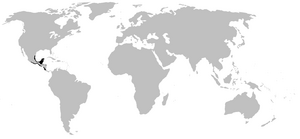Mexican burrowing toad facts for kids
Quick facts for kids Mexican burrowing toad |
|
|---|---|
 |
|
| Conservation status | |
| Scientific classification | |
 |
|
| Distribution of R. dorsalis (in black) |
The Mexican burrowing toad (Rhinophrynus dorsalis) is a very special kind of toad. It's the only species in its group, called Rhinophrynus, and its family, called Rhinophrynidae. This makes it quite unique!
You can find these toads in many places. Their home stretches from southern Texas all the way through Mexico, Belize, Guatemala, Honduras, and El Salvador, down to Nicaragua and Costa Rica. They usually live in warm, dry forests that have wet and dry seasons. But after heavy rains, you might also spot them in fields, ditches, or open areas.
The name Rhinophrynus means 'nose-toad'. It comes from ancient Greek words: rhino- for 'nose' and phrunē for 'toad'. This name fits them well because of their special nose!
For most of the year, the Mexican burrowing toad lives underground. It digs burrows to stay safe and cool. Its body is perfectly built for this underground life.
What Does It Look Like?
Adult Mexican burrowing toads are about 7.5 to 8.5 centimeters (3 to 3.3 inches) long. Female toads are usually bigger than males.
These toads have a short, round body and a cone-shaped head. Their skin is smooth and can be dark gray to maroon-brown. They have cool patterns too, with pale yellow, orange, and red spots and a red stripe down their back.
They have special hard, spade-like tools on their back feet. These help them dig into the ground. Their snout is covered in tiny, tough spines, and their lips have a double seal from special glands. Their eyes are quite small. You can't see their eardrum (tympanum) from the outside.
One very unique thing about this toad is how it catches food. Unlike other frogs that flip their tongue out, the Mexican burrowing toad shoots its tongue straight out from the front of its mouth! This special trick helps it eat underground insects, especially ants and termites.
Life Cycle and Behavior
Mexican burrowing toads are known as "explosive breeders." This means many toads come out of their burrows at the same time to find a mate. This usually happens after the first big rains of the year.
Most of the year, these toads stay hidden underground. When the rains come, the males float on the water's surface. They puff up their bodies and make loud calls to attract females. Most males will then mate with females.
Their mating season is very short, only about 1 to 3 days! After this short time, they burrow back into the ground. They stay there until the next breeding season when the rains return.
Males don't usually fight over females. Instead, they use their calls to communicate. Females seem to choose mates based on how their calls sound. Their main mating call is a loud, low-pitched "wh-o-o-o-a" that lasts about 1.36 seconds. It sounds like a single, rising tone.
They also have another type of call, a "pre-advertisement" call. This one is much shorter, only about 0.25 seconds, and doesn't change tone. Scientists are still learning what this call is for. It might be used for aggression or as a close-range signal to other males.
When a female lays her eggs, both the male and female are underwater. She lays 6 to 12 sticky eggs at a time. These eggs clump together at the bottom of the water. The eggs hatch in just a few days. The tadpoles then grow and develop over one to three months.
A Truly Unique Toad
The Mexican burrowing toad is special in many ways, especially when it comes to its genes and evolution. According to the EDGE of Existence programme, this toad is incredibly unique:
The Mexican burrowing toad is the only species in its genus and family. It has been evolving on its own for over 190 million years! This makes it the most unique amphibian species on Earth today. To give you an idea, a fruit bat, polar bear, killer whale, kangaroo, and even a human are all more similar to each other than this toad is to any other amphibian.
This means the Mexican burrowing toad has a very long and independent evolutionary history. It's truly one of a kind!
See also
 In Spanish: Sapo cavador para niños
In Spanish: Sapo cavador para niños



